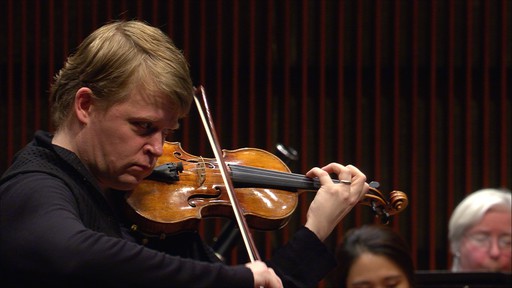
31:01
Editor and Associate Director: Janet Shapiro
Cameras: Patrick Pelham, Donnie Koshiol
Technical Director: Joshua Wyatt
Score Reader: Jeffrey Stirling
Audio Director: Zack Rose, Classical MPR
Executive Producer of Digital Media: Matt Thueson


Finnish composer Magnus Lindberg ranks among the leading musical figures of his generation. Heralded by The Times as “one of the major voices of twenty-first-century composition,” he has received especial acclaim for his large-scale orchestral works, which demonstrate a novel approach to rhythm and sonority. Lindberg achieved particular notoriety for Kraft, his breakthrough work of 1985, scored for large orchestra with solo parts for amplified cello, clarinet, piano, percussion, and electronics; the percussion battery is fortified by objects collected, as per the composer’s instruction, from a local junkyard. He has since frequently been commissioned by the world’s leading orchestras, such as the London Sinfonietta, Los Angeles Philharmonic, Philharmonia Orchestra, Orchestre de Paris, Cleveland Orchestra, Chicago Symphony Orchestra, Berlin Philharmonic, San Francisco Symphony, and New York Philharmonic, for whom he currently serves as composer-in-residence.
Compared to such a work as Kraft, Lindberg’s Violin Concerto employs benign instrumental forces: presumably in salute to Mozart (the Concerto was composed for the 2006 Mostly Mozart Festival), the work calls for a Mozart-sized orchestra comprising pairs of oboes, bassoons, and horns, and a modest complement of strings. But the Concerto’s unassuming instrumentation belies its startling sonic impact. With deliberately meager forces, Lindberg conjures a vast and enchanting soundscape, calling especially upon the folkloric quality of the oboes and horns and deploying spacious voicings in the strings to cinematic effect.
The Concerto’s three movements are played without interruption. As with much of Lindberg’s music over the last two decades, the Concerto’s form is, as the composer describes, “based upon an extended chaconne principle, with chord chains cycling around, undergoing constant transformation and being articulated in a very gestural way.” That is, as with the chaconne of the Baroque period, which involves a sequence of variations built on a repeating ground-bass pattern, much of the Concerto’s germinal melodic and harmonic material is stated at the outset of the piece. The first movement (and longest of the three) begins with the solo violin intoning a melodic fragment that subsequently functions as a generative idea for the entire Concerto.
Lindberg weaves an arresting tapestry from various extensions and transformations of this simple fragment. An exotic subsidiary theme, introduced midway through the movement and which similarly permeates the work in various guises, likewise derives from this introductory phrase, inverting its melodic contour.
The Concerto’s evocative introduction establishes a striking dynamic between soloist and orchestra, in which the solo violin may be heard as the orchestra’s psyche. The strings complement the soloist’s opening utterance, voiced in the violin’s highest, most ethereal register, with soft harmonics; as the solo violin plunges forcefully to its low register, it summons the bassoons and low strings. Whether in concert or in conflict with the orchestra, the soloist serves throughout the work as the catalyst of the Concerto’s dramatic action, dictating the ensemble’s instrumental register, harmonic development, and overall character.
A unified proclamation by the winds signals the onset of the second movement, still restless despite its function as the Concerto’s slow movement. The violin’s languid response steadily intensifies, driving the orchestra towards a climactic fortississimo. The movement ultimately arrives at an extended solo cadenza—an introspective meditation on the Concerto’s thematic material—then proceeds straightaway to the blazing finale, a compact moto perpetuo for which Lindberg reserves the soloist’s most spirited passagework.

We need your support to continue sharing music with people everywhere, completely free of charge.